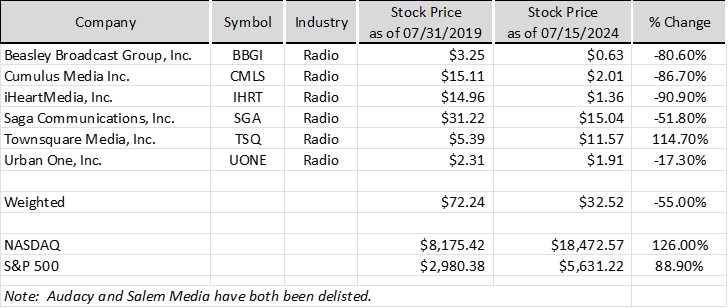The television and radio industries are undergoing significant transformations, influenced by shifts in market dynamics, technological advancements, and ever-changing consumer behaviors. This article, which is based upon our presentation at the May 2024 Media Financial Management Annual Conference, provides a briefing on the current state and future projections for both industries, highlighting critical trends and insights.
TELEVISION INDUSTRY INSIGHTS
Stock Performance Analysis
From July 31, 2019, to July 15, 2024, the television industry saw notable fluctuations in stock prices. Nexstar Media Group Inc. (NXST) emerged as a standout performer, with a 70.1% increase in stock price. Nexstar's success can be attributed to its scale, focus on local content, diversified revenue streams, operational efficiency, strategic acquisitions and investments in digital media. In contrast, other major companies such as Comcast Corporation (CMCSA), The Walt Disney Co. (DIS), and Sinclair Inc. (SBGI) experienced significant declines, underscoring the volatility and challenges within the sector.

Revenue Trends and Projections
Long-term forecasts for the radio industry indicate a decline in Over-The-Air (OTA) revenues, while digital revenues are expected to grow. The consensus forecast suggests a compound annual growth rate (CAGR) of -0.7% for total radio advertising revenues through 2027, with digital revenues rising from 22% to 27% of total revenues during this period. This shift underscores the increasing importance of digital platforms in the radio industry’s revenue mix, although overall industry revenue may continue to face pressures.
EBITDA Margins
Average recurring EBITDA margins for publicly traded radio companies have declined from pre-pandemic levels in the 20% range to the low teens today. Townsquare Media’s margins have remained relatively stable, reflecting its effective cost management and revenue diversification strategies. However, the broader industry has struggled to maintain profitability, with declining margins impacting overall valuations. This trend has necessitated a reassessment of the value of assets like FCC licenses, given the changing financial landscape.
OPPORTUNITIES AND CHALLENGES
Political Revenues
Both the television and radio industries stand to benefit significantly from a markedly increasing political advertising spend, projected to grow substantially in the 2024 election cycle. Political advertising is broadening its scope, encompassing more localized and diverse races, which could provide substantial revenue boosts. This trend highlights the critical role of political cycles in driving revenue for local media companies, offering a recurring but cyclical opportunity for financial uplift.
Digital Revenue Growth
Digital revenues continue to be a bright spot for both sectors. Radio operators, in particular, are leveraging digital platforms to offset declines in traditional advertising revenues. The growth of digital revenues is a key area of focus for media companies aiming to stay competitive and profitable. This shift towards digital is not just a trend, but a necessary adaptation to changing consumer behaviors and market conditions.
The media landscape is evolving rapidly, presenting both challenges and opportunities for the television and radio industries. The insights highlighted here underscore the importance of adapting to changing market dynamics, leveraging new technologies, and diversifying revenue streams. As media companies continue to innovate and adapt, they can uncover new growth avenues and maintain their relevance in an increasingly digital world. Navigating this dynamic environment will be crucial to sustaining growth and profitability in the years to come.
This article was written by Matt Lochte (mattlochte@bondpecaro.com), a Principal and Ben Steinbock (bensteinbock@bondpecaro.com), a Senior Analyst at Bond & Pecaro, Inc. in Washington, DC.
Posted at MediaVillage through the Thought Leadership self-publishing platform.
Click the social buttons to share this story with colleagues and friends.
The opinions expressed here are the author's views and do not necessarily represent the views of